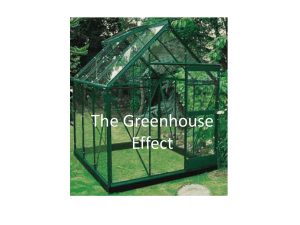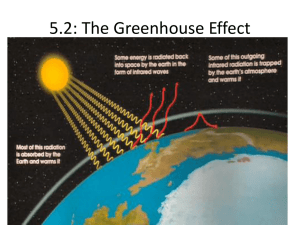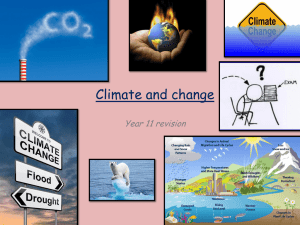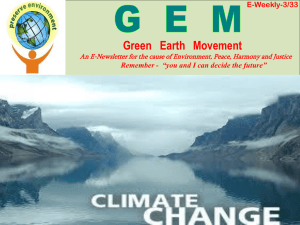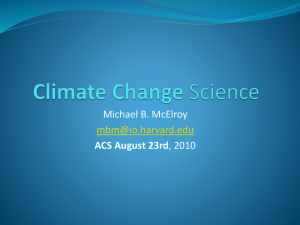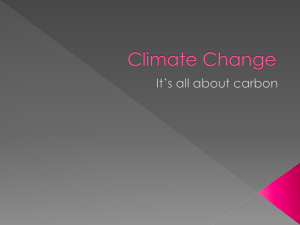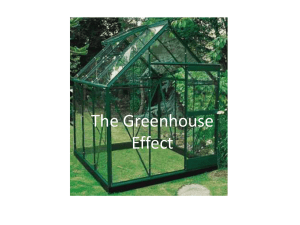File envsci11_c16_pr1
advertisement
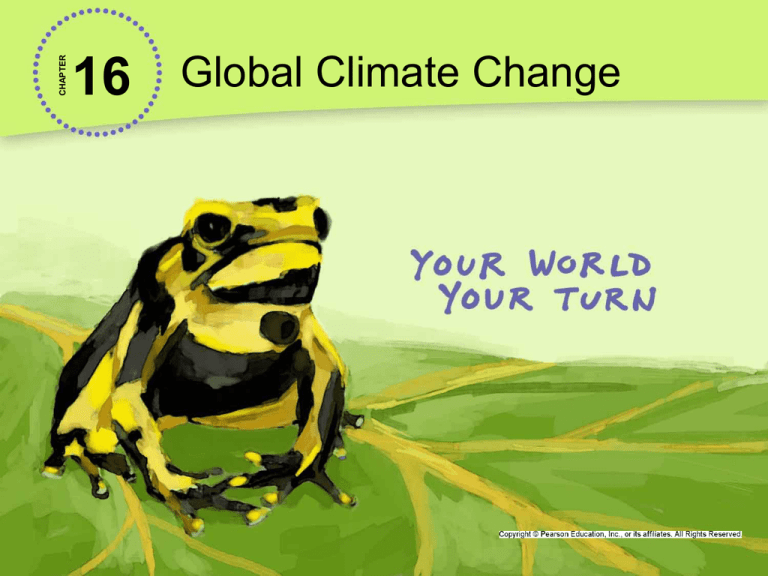
CHAPTER 16 Global Climate Change Rising Seas May Flood the Maldive Islands • Sea levels are rising worldwide. • Scientists link this to global climate change. • Global climate change threatens the Maldives, a group of islands in the Indian Ocean, with flooding, severe storms, erosion, and saltwater contamination. Talk About It Why are rising sea levels a concern for all people, not just those who live on the Maldives Islands? Lesson 16.1 Our Dynamic Climate Without greenhouse gases, Earth would be too cold to support life. Lesson 16.1 Our Dynamic Climate The Greenhouse Effect • A natural process in which greenhouse gases absorb heat and release it slowly back into the atmosphere • Greenhouse gases do not trap energy that has been converted to heat at Earth’s surface. Did You Know? Greenhouse gases absorb heat and release it slowly, while an actual greenhouse traps warm air inside a structure. Lesson 16.1 Our Dynamic Climate The Effect of Latitude • Latitude is a measure of a place’s distance from the equator. • In general, the greater the latitude, the cooler a location’s overall climate will be. • The seasons are also caused by the changing angles at which sunlight strikes Earth. Lesson 16.1 Our Dynamic Climate Wind • Caused by convection currents resulting from rising warm air and falling cool air • Transports moisture and heat • Global wind patterns move warm air away from equator, toward poles. • Cold air moves from poles toward equator. • Winds pick up moisture and can carry it for long distances until it falls as precipitation. Lesson 16.1 Our Dynamic Climate The Oceans and Climate • Ocean currents, which are caused by a combination of unequal heating of water and unequal salinity, affect climate by transporting heat. • El Niño and La Niña are disruptions to normal climate patterns caused by variations in the typical interactions between the ocean and the atmosphere. Did You Know? The ocean absorbs a lot of carbon dioxide, causing a global cooling effect. The ocean can hold 50 times more CO2 than is found in the atmosphere. Lesson 16.1 Our Dynamic Climate Other Factors That Affect Climate • Topography: Higher altitudes have cooler temperatures; mountain ranges affect rainfall patterns. • Volcanoes: Gases and particles can temporarily block sunlight, causing air to cool. • Vegetation: Plant life promotes cloud formation and absorbs carbon dioxide. • Earth’s orbit: Changes in Earth’s orbit and the tilt of Earth’s axis affect the distribution of solar radiation. Did You Know? Ice ages are at least partially caused by changes in Earth’s orbit and axis. Mount St. Helens Lesson 16.2 Climate Change According to NASA’s Goddard Institute for Space Studies, 2009 tied for second warmest year on record, just behind 2005. The decade spanning 2000–2009 was the warmest on record. Lesson 16.2 Climate Change Evidence of a Warming Earth • Rising global surface temperatures • Changes in precipitation patterns • Melting ice (glaciers, polar ice) • Rising sea level Both photos show Sperry Glacier in Montana’s Glacier National Park. Top: 1913: Bottom: 2008 Did You Know? Since 1986, the Larsen Ice Shelf near Antarctica has lost an area more than 3 times the size of Rhode Island. Lesson 16.2 Climate Change Studying Climate Change • Direct measurement is used to study today’s climate. • Proxy indicators, such as patterns in tree rings, give clues about past climates. • Models are used to make predictions about future climates. Cross-section of a tree trunk Lesson 16.2 Climate Change Finding the Cause of Climate Change • According to studies, increases in greenhouse gases are the primary cause of climate change. • The increase in greenhouse gases is mainly due to burning of fossil fuels and changes in land use. Lesson 16.3 Effects of Climate Change In 2003, a severe heat wave in Europe killed 35,000 people. Lesson 16.3 Effects of Climate Change Effects on Organisms • Habitats shift, usually toward the poles or to higher altitudes. • Migrations start earlier in the spring. • Loss of ice makes hunting seals difficult for polar bears. Migrating sandhill cranes Did You Know? Robins arrive on a Colorado mountaintop about 2 weeks earlier than they did in 1970. Lesson 16.3 Effects of Climate Change Effects of a Changing Ocean • An increase in ocean temperature is associated with a process called coral bleaching, in which algae living within corals die. Without the algae, coral cannot survive. • Changes in ocean acidity, resulting from an increase in dissolved carbon dioxide, can harm organisms. The color of healthy brain coral comes from algae. When the algae die, coral bleaching occurs. Lesson 16.3 Effects of Climate Change Current Effects of Global Climate Change • Agriculture and forestry: Effects are complex. • Can be positive: Lengthened growing season for some crops • Can be negative: Droughts and forest fires • Economy: Decreased yields; increased property damage due to severe storms and climate conditions • Human health: Extreme heat waves increasingly common, can cause heat stroke and death Damage caused by Hurricane Katrina, in 2005 Lesson 16.3 Effects of Climate Change Future Effects of Climate Change • Diseases: Warmer temperatures can promote spread of diseases transmitted from animals to people. • Sea level: Low-lying populated coastal areas may flood as sea levels rise. • Water supply: Saltwater contamination of aquifers resulting from rising sea levels and a decrease in glacial ice may threaten freshwater supplies. Did You Know? In the United States, 53% of the population lives in coastal areas. Black-legged ticks, known to spread Lyme disease Lesson 16.4 Responding to Climate Change Fossil fuel combustion generates 70% of the electricity used in the United States. Energy conserving light bulbs Lesson 16.4 Responding to Climate Change Use and Production of Electricity • Carbon footprint: The amount of carbon dioxide for which an individual or group is responsible • Most electricity is generated by burning fossil fuels. • Reducing electricity use reduces carbon footprints. • Ways to reduce electricity use: • Use energy-efficient technologies, which lessen the electricity needed to do a job. • Reduce the use of electrical devices and appliances. Lesson 16.4 Responding to Climate Change Alternate Sources of Electricity • Alternative Sources of Electricity • Nuclear power • Solar power • Wind power • Hydroelectric power • Geothermal power Wind turbines Lesson 16.4 Responding to Climate Change Advances in Vehicle Technology • Transportation is the second largest source of greenhouse gas emissions in the United States, second only to electricity. • Alternatives to fuel-only cars include: • Gasoline-electric hybrid vehicles • Vehicles that use alternative fuels such as compressed natural gas • Vehicles that use hydrogen fuel cells. Energy Loss in a Car Lesson 16.4 Responding to Climate Change Reducing Dependence on Cars • Biking, walking, and using public transportation are all ways to reduce fossil fuel use. • Many communities lack good public transportation. Did You Know? The average American family makes 10 trips by car each day. Lesson 16.4 Responding to Climate Change Strategies for Reducing Greenhouse Gases • Agriculture / forestry: Reduce soil erosion and replace cut trees, to curb CO2 emissions • Cap-and-Trade: System of emission allowances that can be sold or traded, gives companies incentive to reduce emissions • Carbon tax: A tax per unit on emissions • Carbon offsets: Instead of directly reducing emissions, companies can make a voluntary payment to a group that reduces or curbs greenhouse gases. • Carbon sequestration: Technology is used to trap and store carbon dioxide emissions. Lesson 16.4 Responding to Climate Change Cooperation Among Nations • The Kyoto Protocol is a binding international effort to reduce greenhouse gases to below 1990 levels. • The United States did not sign the Kyoto Protocol. • Many nations are planning to develop a new binding agreement to address global climate change some time in the future.


